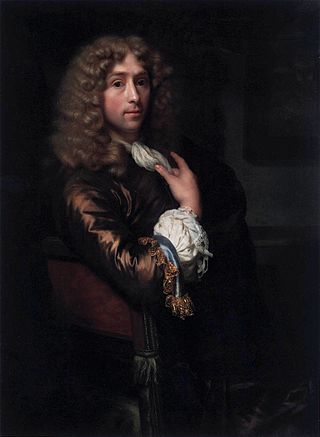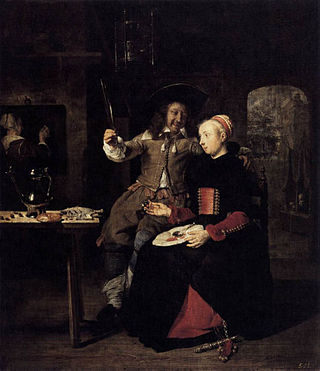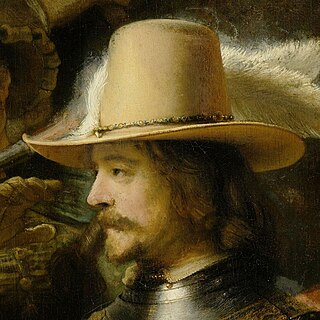
Baroque painting is the painting associated with the Baroque cultural movement. The movement is often identified with Absolutism, the Counter Reformation and Catholic Revival, but the existence of important Baroque art and architecture in non-absolutist and Protestant states throughout Western Europe underscores its widespread popularity.

Gerrit Dou, also known as GerardDouw or Dow, was a Dutch Golden Age painter, whose small, highly polished paintings are typical of the Leiden fijnschilders. He specialised in genre scenes and is noted for his trompe-l'œil "niche" paintings and candlelit night-scenes with strong chiaroscuro. He was a student of Rembrandt.

Gerard van Honthorst was a Dutch Golden Age painter who became known for his depiction of artificially lit scenes, eventually receiving the nickname Gherardo delle Notti. Early in his career he visited Rome, where he had great success painting in a style influenced by Caravaggio. Following his return to the Netherlands he became a leading portrait painter. Van Honthorst's contemporaries included Utrecht painters Hendrick Ter Brugghen and Dirck van Baburen.

Frans van Mieris the Elder, was a Dutch Golden Age genre and portrait painter. The leading member of a Leiden family of painters, his sons Jan (1660–1690) and Willem (1662–1747) and his grandson Frans van Mieris the Younger (1689–1763) were also accomplished genre painters.

Willem van Mieris was an 18th-century painter from the Dutch Republic.

Geertgen tot Sint Jans, also known as Geertgen van Haarlem, Gerrit van Haarlem, Gerrit Gerritsz, Gheertgen, Geerrit, Gheerrit, or any other diminutive form of Gerald, was an Early Netherlandish painter from the northern Low Countries in the Holy Roman Empire. No contemporary documentation of his life has been traced, and the earliest published account of his life and work is from 1604, in Karel van Mander's Schilder-boeck.

Godfried Schalcken was a Dutch artist who specialized in genre paintings and portraits. Schalcken was noted for his night scenes and mastery in reproducing the effect of candlelight. He painted in the highly polished style of the Leiden fijnschilders.

Gabriël Metsu (1629–1667) was a Dutch painter of history paintings, still lifes, portraits, and genre works. He was "a highly eclectic artist, who did not adhere to a consistent style, technique, or one type of subject for long periods". Only 14 of his 133 works are dated.

Vrouw Maria was a Dutch wooden two-masted merchant ship carrying a valuable cargo of art objects, captained by Raymund Lourens, that sank on 9 October 1771 in the outer archipelago of the municipality of Nagu, Finland, 11 kilometers south-east of the island of Jurmo. In 1999, the ship was discovered by the members of Pro Vrouw Maria, led by Rauno Koivusaari. A dispute between the discoverers and the authorities was later resolved. The ship was in good condition when it was discovered, but only six objects from the deck of the ship have been salvaged. The cargo holds have not been disturbed, so the condition of any art on board remains unknown. The Finnish National Board of Antiquities is responsible for the ship and all recovery efforts.

The Milkmaid, sometimes called The Kitchen Maid, is an oil-on-canvas painting of a "milkmaid", in fact, a domestic kitchen maid, by the Dutch artist Johannes Vermeer. It is in the Rijksmuseum in Amsterdam, the Netherlands, which regards it as "unquestionably one of the museum's finest attractions".

The Reynst Collection, probably the most extensive Dutch 17th-century collection of art and artefacts, was owned by the Dutch merchants Gerrit Reynst and Jan Reynst. The collection was put on display in their house at the sign of Hope on the Keizersgracht in Amsterdam. It consisted of over 200 Italian paintings and over 300 sculptures, most of them ancient Roman. There were other antiquities: ten sepulchral monuments, five votive reliefs, nine cinerary urns, "Etruscan" vases, and Christian objects, as well as engraved gems. The collection was dispersed in the 1660s and 1670s, after both brothers had died, and Gerrit's widow sold parts to various buyers.

Gerrit de Graeff belonged to the patrician class of Amsterdam and held the feudal titles Free Lord of Zuid-Polsbroek as those of 21st Purmerland and Ilpendam. Known for his wealth and notorious for his stinginess, De Graeff was not particularly popular.

Jacob Toorenvliet (1640–1719) was a Dutch Golden Age painter of genre works.

Willem van Ruytenburch, lord of Vlaardingen and Vlaardingen-Ambacht (1600–1652) was a member of the Dutch gentry and Amsterdam patriciate of the Dutch Golden Age. He became an alderman of Amsterdam and joined the Schutterij of Frans Banninck Cocq. Willem was featured, as a lieutenant, in Rembrandt's 1642 painting The Night Watch for which he is now probably most famous.

Jan Anthonie Coxie or Anthonie Coxie was a Flemish painter and draughtsman mainly known for his portrait and history paintings. After starting his career in Flanders he moved abroad and worked in Amsterdam, Berlin, Mainz and Milan where he worked for an elite clientele.

A Mother's Duty (1658–1660) is an oil-on-canvas Dutch Golden Age painting by the Dutch painter Pieter de Hooch. It is part of the collection of the Amsterdam Museum, on loan to the Rijksmuseum.

The Young Mother is an oil painting by Dutch artist Gerrit Dou, from 1658. The signature of the artist appears subtely in the stained glass window, GDOV.1658. This genre piece has been part of the collection of the Mauritshuis, in The Hague, since 1822.

Old Woman Reading, also known as Old Woman Reading a Lectionary, is an oil painting by the Dutch painter Gerrit Dou, made c. 1631–1632. In the past the work was attributed to Rembrandt and was titled Rembrandt's Mother, but this attribution has long been rejected. The portrait has been part of the collection of the Rijksmuseum, in Amsterdam, since November 1912.




















